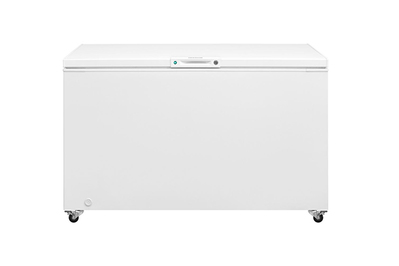
Our picks have been discontinued, and we don’t have new ones to share at this time.
December 2023Chest freezers generally all perform about the same and tend to be reliable, so any model you buy should work fine. That said, we like the GE FCM11PHWW because it has all the most critical features you should expect from a chest freezer, including a power-on indicator light, a safety lock to keep kids out, and an interior light. It also has leveling legs for uneven flooring, three sliding storage baskets, and front temperature controls.

This chest freezer includes everything you need, plus a few extras you don’t often find in a freezer of this size or price.

A larger option than our top pick, this 14.8-cubic-foot Frigidaire comes with removable casters.

This chest freezer includes everything you need, plus a few extras you don’t often find in a freezer of this size or price.
Although the 10.6 cubic feet of capacity in the GE FCM11PHWW might seem small, chest freezers actually have more usable space for a given capacity than upright freezers, so this model should offer plenty of room for the goodies from big Costco trips. GE does make larger chest freezers, but owners don’t rate them as highly, so we suggest looking at our runner-up pick if you need more space.

A larger option than our top pick, this 14.8-cubic-foot Frigidaire comes with removable casters.
If you’d prefer a bigger chest freezer, get a Frigidaire. The 14.8-cubic-foot Frigidaire FFFC15M4TW is the most popular version, though models measuring 12.8, 19.8, and 24.8 cubic feet are available as well. They all have the key features you should expect: a power-on indicator light, a safety lock, two storage baskets, an interior light, and external temperature controls. Unlike the GE, the Frigidaire models also have detachable casters, which will come in handy if you need to move your freezer regularly.
I’ve been covering and writing about appliances for more than five years, first for Reviewed.com and, since 2016, for Wirecutter. I’ve written our guides to stoves, mini fridges, and upright freezers, among others.
For our guides to the best freezers, we put in more than 40 hours of research. Although we weren’t able to test any of these freezers ourselves, we looked through hundreds of models and owner reviews, and we interviewed several experts, including Heather Marold Thomason, a butcher and founder of Primal Supply Meats in Philadelphia; Michael Dulock, butcher and owner of M.F. Dulock Pasture-Raised Meats in Somerville, Massachusetts; Benjamin Liebert, vice president of cold products at Frigidaire; Varun Rajasekaran, senior director of cold products at Electrolux; Jill A. Notini, vice president of communications and marketing at the Association of Home Appliance Manufacturers; Tony Bouza, HVAC, water heating, and appliances technology manager at the US Department of Energy’s EERE Building Technologies Office; and Tim Ellis, merchandise senior manager of refrigeration at GE Appliances. We also consulted a few anonymous hunters in an online hunting forum.
If you find yourself running out of space in your fridge’s freezer, you might want a standalone freezer. They’re especially useful for large families, hunters, and people who host a lot of dinner guests, but anyone who would like to take fewer trips to the grocery store will appreciate being able to store a bunch of food.
Chest freezers, which look sort of like coffins, are great for this purpose because they offer more usable space than upright freezers, tend to cost less, use less energy, and better avoid freezer burn.
Although chest freezer sizes vary—you can find models offering capacities from 5 to 25 cubic feet—they usually take up more floor space than upright freezers, up to 3 by 6 feet with some 22-cubic-foot models. However, they offer a lot more usable space than uprights with identical capacities, since for long-term storage you can just stack items on top of one another rather than placing them on refrigerator-style shelves as you would in an upright model. (We focused on larger-capacity units for this review, but we know there’s a lot of interest in smaller freezers, especially those with 5- to 7-cubic-foot capacities. We’re working on a separate guide for those.)
You’ll generally save money with a chest freezer. Compared with similarly sized upright freezers, chest freezers tend to cost about $50 to $100 less to buy. They also save about $10 to $20 worth of energy per year (assuming average energy prices). This happens for a few reasons, as Tony Bouza of the US Department of Energy explained to us. First, chest freezers have “built-in sidewall insulation,” Bouza said. Second, “chest freezers maintain temperature better when the lid or drawer is opened and closed” because “cold air tends to stay at the bottom” of a chest freezer, whereas upright freezers let cold air seep out. And third, chest freezers do not have automatic defrost cycles, and as a result they “use half the energy” that most upright freezers do (though you will likely need to manually defrost your chest freezer from time to time).